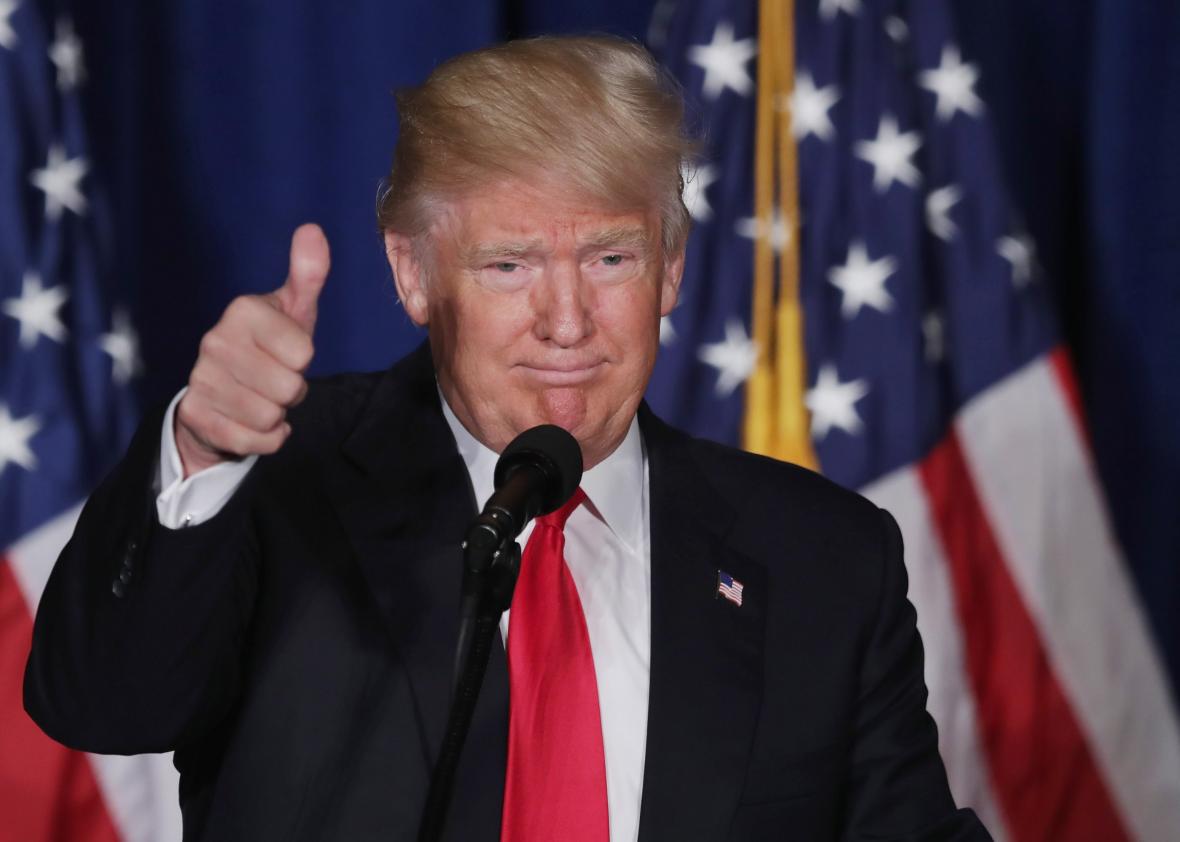I hate doing this. But Donald Trump said something somewhat outlandish-sounding that happens to be correct and people are intrigued. So here goes.
A few days ago during an interview with CNBC, the Republican Party’s presumptive presidential nominee seemed to suggest that, if the U.S. ran into trouble with its debt, he would ask creditors to accept partial repayments—which is to say, he’d go kamikaze and default. “I would borrow, knowing that if the economy crashed, you could make a deal,” he said. “And if the economy was good, it was good. So, therefore, you can’t lose.” Binyamin Appelbaum of the New York Times noticed these comments and helpfully pointed out that they were absolutely insane—the merest whisper of a hint that the U.S. president would be open to a default would rock global markets to their core. Of course Trump, being Trump, hedged his initial crazy talk, suggesting that what he really wanted to do was buy back U.S. debt at a discount. This, as Appelbaum noted, is a dubious but somewhat less bone-chilling idea.
But Trump—being Trump—is still peeved about the Times’ reporting. So on Monday morning he went to town on the paper and in the process let loose an interesting comment: “This is the United States government. First of all, you never have to default because you print the money. I hate to tell you. So there’s never a default. But the point is it was reported in the New York Times incorrectly.”
What’s this? The U.S. can never default? Is it true? You can get deep in the weeds here, but for all practical purposes, yes, Trump is right. When a country prints its own currency, markets don’t typically worry about them running out of money, and thus are willing to lend freely. That allows nations like the U.S. to issue new debt in order to cover their old obligations. This is why comparisons between the U.S. and Greece are inherently ridiculous. Greece uses the euro, which it does not control, and therefore only has a finite sum of money at its disposal to make good on what it owes. Its coffers can run dry. The U.S., on the other hand, has infinite dollars.
There is a catch, of course. At some point, if the U.S. borrows and spends enough, that could lead to a major bout of inflation. For creditors, severe inflation can be the equivalent of a default, since the value of their bonds drop. As a rule, markets seemingly worry less about that possibility than they do about outright nonpayment. But in the far-off nightmare scenario wherein the U.S. suddenly turns into a full-on Venezuela- or Zimbabwe-style basket case, that might keep us out of the debt markets, in which case we’d have to pray for the benevolent folks at that the Federal Reserve to co-operate either by buying Treasurys or letting the government overdraw its account. But again, that’s all deep down this rabbit hole.
This all serves a narrow, but important, point. The fact that the U.S. controls its own currency does give us flexibility when it comes to debt. If it weren’t for our ridiculous, self-imposed debt ceiling, default would rarely, if ever, be something people seriously discussed.1 You can tack this onto the short list of things, along with monetary policy, that Trump seems to be clear-headed about.
That doesn’t necessarily include the broader issue of managing the U.S. debt, however. Trump seems to have imported his idea about buying back U.S. Treasurys at a discount from the corporate world. When companies get into trouble and the markets start doubting their credit-worthiness, the value of their bonds tends to drop. If those companies happen to have cash on hand, that gives them a chance to buy back their own debt for less than face value. (Donald Trump’s own distressed companies have apparently used this move.) Now how might this apply to America’s sovereign debt? Well, when interest rates rise, prices on old Treasurys fall. (After all, if you can get a new bond at a higher yield rate, why would you pay as much for an old one with a lower yield?) So Trump thinks that “if interest rates go up and we can buy bonds back as a discount, if we are liquid enough as a country we should do that.”
This would not be totally without precedent. The U.S. Treasury actually went on a bond-buyback spree during the budget-surplus era of the early 2000s, though it was mostly designed to do technical things like manage the supply of Treasurys available at different maturity rates. But if it really wanted to, the U.S. could probably repeat the trick in order to cut its debt. Dean Baker and Sheva Diagne of the Center for Economic and Policy Research have argued that buybacks could shave as much as $458 billion from America’s tab.* “Of course exchanging debt in this manner serves no obvious purpose,” they write. “The interest burden on the Treasury will not change through these transactions.” That’s because the U.S. runs a budget deficit, and so in order to retire old debt, the U.S would have to issue new, higher-interest bonds.
If you believe Baker and Diagne, Trump’s bond-market high jinks would, like some tastefully applied gold leaf, make our debt-to-GDP ratio, which Republicans and global technocrats alike tend to fetishize, a bit prettier, without making a substantive difference to America’s financial health. So please don’t pay too much attention to the trees. Donald Trump is still lost in a forest of nonsense.
1Though, who wants to bet that President Trump would just go ahead and mint the $1 trillion coin?
*Correction, May 9, 2016: This post originally misidentified the Center for Economic and Policy Research as the Center on Budget and Policy Priorities. It also misspelled Sheva Diagne’s first name.
